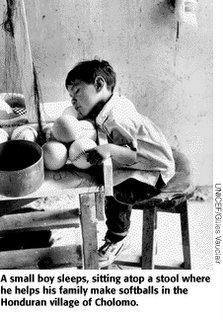
Who built the seven gates of Thebes?
The books are filled with names of kings.
Was it kings who hauled the craggy blocks of stone?...
In the evening when the Chinese wall was finished
Where did the masons go? Imperial Rome
Is full of arcs of triumph. Who reared them up?...
Young Alexander conquered India.
He alone?
Caesar beat the Gauls.
Was there not even a cook in his army?...
Each page a victory.
At whose expense the victory ball?
Every ten years a great man,
Who paid the piper?
- Brecht, A Worker Reads History
I began the lesson with a beat-up soccer ball.
The ball sat balanced in a plastic container on a stool in the middle of the circle of student desks. "I'd like you to write a description of this soccer ball," I told my high school Global Studies class. "Feel free to get up and look at it. There is no right or wrong. Just describe the ball however you'd like."
Looks of puzzlement and annoyance greeted me. "It's just a soccer ball," someone said.
Students must have wondered what this had to do with Global Studies. "I'm not asking for an essay," I said, "just a paragraph or two."
As I'd anticipated, their accounts were straightforward -- accurate if uninspired. Few students accepted the offer to examine the ball up close. A soccer ball is a soccer ball. They sat and wrote. Afterwards, a few students read their descriptions aloud. Brian's is typical:The ball is a sphere which has white hexagons and black pentagons. The black pentagons contain red stars, sloppily outlined in silver... One of the hexagons contains a green rabbit wearing a soccer uniform with "Euro 88" written parallel to the rabbit's body. This hexagon seems to be cracking. Another hexagon has the number 32 in green standing for the number of patches that the ball contains.
But something was missing. There was a deeper social reality associated with this ball -- a reality that advertising and the consumption-oriented rhythms of U.S. daily life discouraged students from considering. "Made in Pakistan" was stenciled in small print on the ball, but very few students thought that significant enough to include in their descriptions. However, these three tiny words offered the most important clue to the human lives hidden in "just a soccer ball" -- a clue to the invisible Pakistanis whose hands crafted the ball sitting in the middle of the classroom.
Interesting blog. Enjoyed reading it.
ReplyDeleteSincerely,
Joseph Smith Jr.
polygamy
http://www.whatismormonism.com